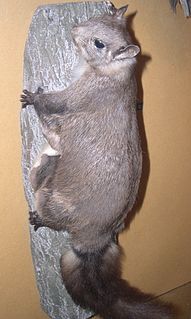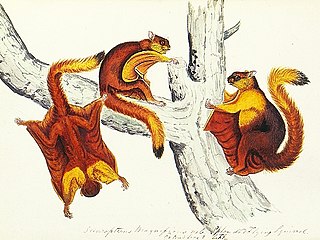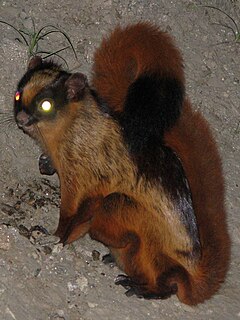
Flying squirrels are a tribe of 50 species of squirrels in the family Sciuridae. They are not capable of flight in the same way as birds or bats but are able to glide from one tree to another with the aid of a patagium, a furry, parachute-like membrane that stretches from wrist to ankle. Their long tails provide stability in flight. Anatomically they are very similar to other squirrels but have a number of adaptations to suit their lifestyle; their limb bones are longer and their hand bones, foot bones, and distal vertebrae are shorter. Flying squirrels are able to steer and exert control over their glide path with their limbs and tail.

Sciurinae is a subfamily of squirrels, uniting the flying squirrels with certain related tree squirrels. Older sources place the flying squirrels in a separate subfamily (Pteromyinae) and unite all remaining sciurids into the subfamily Sciurinae, but this has been strongly refuted by genetic studies.

Biswamoyopterus is a genus of rodent in the family Sciuridae. It contains three known species of very large flying squirrels, with B. laoensis being among the longest of all squirrels. They are distributed in forests in northeast India, southwest China and Laos. Despite their size, species in this genus tend to be very elusive; due to this, all of them have been described relatively recently. Additionally, they are easily confused with certain Petaurista giant flying squirrels that are more common and overlap in range with the rare Biswamoyopterus.

The Namdapha flying squirrel is an arboreal, nocturnal flying squirrel endemic to Arunachal Pradesh in northeast India, where it is known from a single specimen collected in Namdapha National Park in 1981. No population estimate is available for B. biswasi, but the known habitat is tall Mesua ferrea jungles, often on hill slopes in the catchment area of Dihing River in northeastern India.

The red giant flying squirrel or common giant flying squirrel is a species of rodent in the family Sciuridae (squirrels). It is found in a wide variety of forest–types, plantations and more open habitats with scattered trees in Southeast Asia, ranging north to the Himalayas and southern and central China. One of the largest arboreal squirrels, all populations have at least some reddish-brown above and pale underparts, but otherwise there are significant geographic variations in the colours. The taxonomic position of those in the Sundaic region is generally agreed upon, but there is considerable uncertainty about the others, which variously have been included in this or other species, or recognized as their own species.

Hylopetes is a genus of flying squirrels. There are about 8 or 9 species.
Vinckeia is a subgenus of the genus Plasmodium — all of which are parasitic alveolates. The subgenus Vinckeia was created by Cyril Garnham in 1964 to accommodate the mammalian parasites other than those infecting the primates.
Plasmodium watteni is a parasite of the genus Plasmodium subgenus Vinckeia. As in all Plasmodium species, P. watteni has both vertebrate and insect hosts. The vertebrate hosts for this parasite are mammals.

The particolored flying squirrel is a species of rodent in the family Sciuridae. It is found in Bangladesh, Bhutan, Cambodia, China, India, Laos, Myanmar, Nepal, Thailand, and Vietnam. Its natural habitat is subtropical or tropical dry forests. It is threatened by habitat loss.

Petaurista is a genus of rodent in the family Sciuridae. They are large to very large flying squirrels found in forests and other wooded habitats in southern and eastern Asia.

The spotted giant flying squirrel, also known as the lesser giant flying squirrel, is a species of rodent in the family Sciuridae. It is found in hill and mountain forests at altitudes of 200–4,000 m (660–13,120 ft) in Southeast Asia north to central China and the east Himalayan region, although the northern populations sometimes are regarded as separate species as the grey-headed giant flying squirrel, Chindwin giant flying squirrel and P. marica. Two of these, as well as a few other populations, lack the white spots on the upperparts for which it is named. Although a large flying squirrel, it is a relatively small giant flying squirrel.

Hodgson's giant flying squirrel is a species of rodent in the family Sciuridae. This large flying squirrel lives in Himalayan forests in Asia. Like other flying squirrels, it is nocturnal and able to glide long distances between trees by spreading out its patagium, skin between its limbs.

The Bhutan giant flying squirrel, also known as the gray's giant flying squirrel or noble giant flying squirrel, is a species of rodent in the family Sciuridae. This species lives in Himalayan forests and it is one of the largest flying squirrels. Like other flying squirrels, it is mainly nocturnal and able to glide long distances between trees by spreading out its patagium, skin between its limbs.

The Indian giant flying squirrel, also called the large brown flying squirrel or the common giant flying squirrel, is a species of rodent in the family Sciuridae. It is capable of gliding flight using a skin membrane stretched between front and hind legs. It is found in mainland Southeast and South Asia, and southern and central China.

The Eastern Himalayan subalpine conifer forests is a temperate coniferous forests ecoregion which is found in the middle and upper elevations of the eastern Middle Himalayas, in western Nepal, Bhutan and northern Indian states including Arunachal Pradesh.
The Mechuka giant flying squirrel is a species of rodent in the family Sciuridae. First described in 2007 from East Himalayan forests at altitudes of 1,500–2,500 m (4,900–8,200 ft) in the region of Mechuka of north-central Arunachal Pradesh in India, its taxonomic status and position is not fully resolved. it was originally described as P. nigra but has been replaced by mechukaensis because it was a primary homonym of P. nigra Wang 1981.
The Mishmi giant flying squirrel is a species of rodent in the family Sciuridae. First described in 2009 from East Himalayan forests at altitudes of 600–1,600 m (2,000–5,200 ft) in the Mishmi Hills of northeastern Arunachal Pradesh in India, the taxonomic status and position of this giant flying squirrel is not fully resolved.
The Mebo giant flying squirrel is a species of rodent in the family Sciuridae. It was first described in 2013 from the East Himalayan forests of Upper Siang District, Arunachal Pradesh in India.











